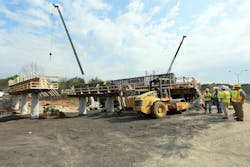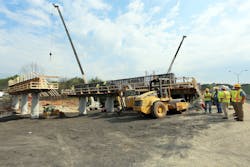Quick connect
When the flames were still full of life, the Georgia Department of Transportation (GDOT) was staring at plans from about three decades ago.
The I-85 bridge over Piedmont Road in metro Atlanta was burning on March 30, but officials were hopeful portions would be spared, and they wanted to be ready. So before damage could be assessed, before emergency responders even had the upper hand on the fire that was engulfing the bridge, GDOT had the original designs out and started considering what might be needed in way of repair.
“We knew, as did the public, that one span had to be replaced,” Marc Mastronardi, GDOT construction division director, told Roads & Bridges.
According to Mastronardi, the existing bridge had AASHTO type 5 prestressed concrete girders in place, which are no longer common. However, GDOT designers were confident a special prestressed concrete girder could be designed and allowed for retrofitting with today’s specifications.
When the smoke cleared, six spans—three northbound and three southbound (100-ft section)—were lost due to the heat damage, and the salvageable substructure was limited to portions of the columns. C.W. Matthews Contracting Co. Inc., which in 2001 repaired I-285 over S.R. 400 following a tanker fire, was selected as the prime contractor for the rebuild.
Speeding in place
When GDOT was going over options to replace the damaged portion of I-85, accelerated bridge construction, where a deck is slid into place, was immediately crossed off the list. The bridge, and I-85 itself, is not surrounded by available landscape. Over 240,000 vehicles travel the route every day, so a quick rebuild was essential. The agency also was approached by many companies that make temporary bridge structures, but the elevation of the roadway and skewed angle of the bents made that an impossibility. Since all of the columns survived the blaze it was decided to execute accelerated construction in-place so the bridge could reopen by June 15.
After DH Griffin rubblized the decks and beams that needed to be removed over the course of seven days—which resulted in 13 million lb of debris—columns were cut beneath the cap and jacketed with additional steel and concrete. Four caps also were poured in-place to make way for beam placement and typical construction. Twenty-eight No. 9 and 10 bars, depending on the column, were added vertically to the remaining core with hoops rising on 12-in. centers to the bottom of the cap. Crews utilized a 24-hour concrete mix design that included fiber in the pours. Design strength of 3,500 psi was achieved in 19 hours, on average.
At press time, 31 of the necessary 61 beams were already in place, and all of the beams were supposed to be set by April 26.
Of the six spans two are trapezoidal and two are curved, so the beams will have slight differences from interior to exterior in both directions.
“The trapezoidal sections are all single-cast design and it only takes one beam to hold the whole job up,” said Mastronardi. “Every couple of days it looks like tremendous progress, but the bridge deck work is a little more tedious. That is when the job will slow down a little, as far as perception goes.”
GDOT decided to execute accelerated bridge construction in-place to reopen the bridge by June 15.
Communicating clearly
GDOT’s communications staff also got out in front of the storm by scheduling a press conference with all the major players involved and increasing activity on social media. Progress videos are sometimes posted twice a day.
“In a normal situation in Georgia, like winter weather, they may be dealing with 20 media outlets,” Meg Pirkle, chief engineer with GDOT, told Roads & Bridges. “In this situation they were dealing with over a hundred calling and wanting direct access to the commissioner and one-on-one interviews.”
Traffic is being detoured to I-285 as well as I-75 to the north, and travel times have increased 20 to 40 minutes since the collapse. However, communication could have easily been thrown into crisis mode. The fire knocked out GDOT’s navigator system, which is linked to cameras, the state’s 5-1-1 system and carries out all of the messages for overhead signs. A back-up system kicked in a minute later and everything has been running smoothly ever since. On top of the variable message boards the agency has deployed portable changeable message signs and hard detour signage.
Gwinnett Transit, the Georgia Regional Transportation Authority and MARTA have all increased their transit service in an attempt to lighten traffic. The Atlanta Regional Commission also has what it calls the Commute Options Program that is funded through GDOT and offers travelers $5 a day if they try a different mode of transportation. The neighborhood routes that surround I-85, however, have still been clogged.
“Our communications team and [the Atlanta Regional Commission and city of Atlanta] have been able to get the word out that employers need to be flexible and allow their employees to work alternate hours and telecommute,” said Pirkle. “We have gotten a great response from the business community.”
Finish early? Money
It was determined road user costs, at the high end, were at $850,000 a day. With that in mind, C.W. Matthews will receive a $1.5 million bonus if the bridge is opened by May 25, and a $2 million bonus if it is up and running by May 21. Ideally, I-85 will be back to normal by the Memorial Day weekend. If C.W. Matthews completes the job before May 21 it can receive a max bonus of $3.1 million. However, every day after June 15 carries a $200,000 penalty.
“Right now we feel pretty comfortable with that June 15 date,” said Mastronardi. “We have had good weather but they have progressed the job I think better than anybody’s expectations at the moment.”

